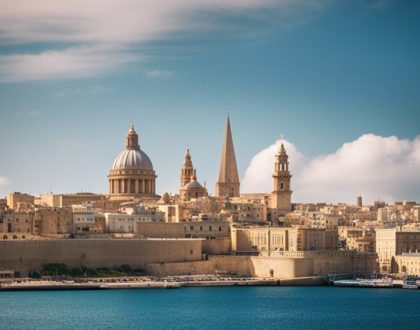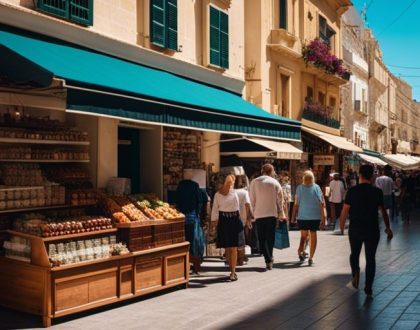A Photographer’s Guide to Malta
Getting to Know Malta: A Photographic Paradise
For photographers, Malta is a treasure trove waiting to be discovered. This small Mediterranean island nation offers a diverse range of landscapes, architectural wonders, and vibrant cultural festivals that present countless opportunities for stunning photography. Whether you are capturing the unique light of the Maltese landscape, the rich history through its architecture, or the lively atmosphere of its festivals, Malta is sure to inspire any photographer.
Malta's Unique Landscape and Light
Now, let’s talk about Malta’s unique landscape and light. The island’s limestone cliffs, crystal-clear blue waters, and hidden coves provide the perfect backdrop for striking photographs. The Mediterranean sun bathes the scenery in a warm, golden light, creating a photographer’s dream setting. Whether you are exploring the rugged coastline, picturesque villages, or ancient temples, Malta’s landscape offers endless opportunities to capture the natural beauty of the island.
The Rich Cultural Heritage and Architecture
Even more captivating than Malta’s landscapes is its rich cultural heritage and architecture. The island is home to a wealth of historical sites, including UNESCO World Heritage-listed cities, medieval fortifications, and Baroque churches. Each corner of Malta tells a story of its past, from the ancient megalithic temples to the grand palazzos of the Knights of St. John. Photographers will find endless inspiration in the intricate details and timeless beauty of Malta’s architectural marvels.
Another fascinating aspect of Malta’s architecture is the seamless blend of styles influenced by various civilizations that have ruled the island over the centuries. From the Arabic motifs in the medieval architecture to the intricate marble work of the Baroque period, Malta’s buildings are a testament to its vibrant history and cultural diversity.
The Vibrant Festivals and Street Photography Opportunities
Heritage and tradition come to life in Malta through its vibrant festivals and street photography opportunities. Throughout the year, the island is alive with colorful processions, lively music performances, and traditional folk celebrations. From the grandeur of the Valletta Carnival to the solemnity of Holy Week processions, each festival offers a unique insight into Maltese culture and provides photographers with a wealth of dynamic subjects to capture.
For instance, the annual feast of St. Peter and St. Paul in June sees the streets adorned with intricate decorations, beautifully lit up at night, offering photographers the chance to capture the festive spirit of the local community. The lively atmosphere and rich visual details during these celebrations make Malta an ideal destination for photographers seeking to document cultural traditions and street life.
Essential Photography Equipment for Malta’s Diverse Scenes
Camera Gear Essentials
Clearly, when commenceing on a photography adventure in Malta, it’s crucial to have the right equipment to capture the stunning beauty of the landscapes and architecture. A high-quality DSLR or mirrorless camera is imperative for capturing sharp, detailed images in the varied lighting conditions you will encounter on the Maltese islands.
Investing in a versatile zoom lens, such as a wide-angle to telephoto lens, will allow you to capture a wide range of scenes without having to switch lenses constantly. Additionally, packing extra batteries and memory cards is a must, as you don’t want to miss out on a perfect shot due to lack of power or storage space.
Don’t forget to pack a lightweight camera bag to keep your gear safe and organized while exploring the diverse locations in Malta. A sturdy camera strap will also come in handy during long photography sessions, ensuring your camera is always within reach.
Tripods, Filters, and Accessories
Photography in Malta often involves shooting in low light conditions or capturing long exposure shots of the stunning coastal scenes. In such situations, a tripod is imperative to keep your camera steady and avoid any blurriness in your images. Additionally, filters like polarizers or ND filters can help enhance your photos by reducing glare or controlling the amount of light entering the lens.
Essential accessories such as lens cloths, a remote shutter release, and a portable LED light can also elevate your photography game in Malta. These small but mighty tools can make a big difference in achieving the perfect shot, especially in challenging lighting conditions.
Types of tripods vary, with options ranging from compact travel tripods to heavy-duty ones for more stability. Choose a tripod that suits your photography style and needs, ensuring it’s sturdy enough to withstand windy conditions near the coast or on the rugged terrain of Malta.
Tips for Packing and Transporting Equipment
Little organization goes a long way when packing your photography gear for a trip to Malta. Make a checklist of all your imperative equipment, including cameras, lenses, batteries, memory cards, and accessories, to ensure you don’t forget anything important.
- Use padded inserts or dividers in your camera bag to protect your gear during travel.
- Avoid carrying excessive weight by only packing the imperatives for each photography outing.
- Keep your gear secure in crowded tourist areas by using a lockable camera bag or backpack.
Any extra precautions you take to safeguard your equipment will ultimately contribute to a successful and stress-free photography experience in Malta.
Understanding Malta’s Natural Light
Golden Hour and Blue Hour Explained
Light is a crucial element in photography, and in Malta, you will experience some of the most magical natural light conditions. The Golden Hour refers to the period shortly after sunrise or before sunset when the light is soft, warm, and directional, casting beautiful hues on the landscape. This time of day offers photographers the perfect opportunity to capture stunning images with a golden glow.
The Blue Hour is the time before sunrise and after sunset when the sky takes on a deep blue hue. This short-lived period is a photographer’s dream, offering a unique and enchanting light that can add a mystic touch to your photos. Be prepared to make the most of these fleeting moments to create captivating and atmospheric shots.
Understanding these distinctive periods of natural light will elevate your photography in Malta. Keep an eye on the changing light conditions and plan your shots accordingly to take full advantage of these ethereal moments.
Harnessing Harsh Midday Light
You may find yourself faced with harsh midday light during your time in Malta. While this lighting situation can be challenging, you can still capture striking images with the right approach. You can embrace the strong shadows and contrast by focusing on details and textures in your surroundings.
With the sun directly overhead, consider using photography techniques like high contrast black and white shots or experimenting with silhouette photography. Play with light and shadow to create dramatic and impactful compositions that make the most of the midday sun.
Remember that harsh midday light can be both a friend and a foe in photography. Embrace the challenge and use it to your advantage, pushing the boundaries of your creativity and capturing unique images that stand out.
Tips for Night Photography
Now, let’s investigate into capturing Malta’s beauty after the sun sets. Night photography in Malta offers a photographer a whole new realm of creative possibilities. To make the most of your night shots, consider these tips:
- Use a tripod to keep your camera steady in low light conditions.
- Experiment with long exposures to capture light trails and starry skies.
- Adjust your white balance to complement the different hues of artificial light.
After mastering these techniques, you’ll be ready to capture stunning nightscapes of Malta, showcasing the island’s beauty under the stars. Embrace the darkness and let your creativity shine through in your night photography endeavors.
Composition Techniques for Captivating Images
Rule of Thirds in Maltese Landscapes
Unlike other composition techniques, the Rule of Thirds is a fundamental principle that can drastically improve the impact of your photographs. In the picturesque landscapes of Malta, using the Rule of Thirds can help you create visually appealing images that draw the viewer in. By dividing your frame into nine equal parts with two horizontal and two vertical lines, you can position key elements of your composition along these lines or at their intersections to create a harmonious balance.
The stunning cliffs of Dingli, the historic streets of Valletta, and the captivating Blue Grotto are just a few of the iconic locations in Malta where you can apply the Rule of Thirds to elevate your photography. By aligning horizons, architectural details, or subjects of interest with the imaginary gridlines, you can achieve a more balanced and dynamic composition that captures the essence of the Maltese landscapes.
Embracing the Rule of Thirds in your photographic compositions in Malta will not only enhance the visual appeal of your images but also provide a structured approach to organizing the elements within the frame. Experiment with this technique in different locations across Malta to discover how it can transform your photography.
Leading Lines and Framing Tricks
Images that incorporate leading lines and framing tricks are inherently engaging and guide the viewer’s eye through the photograph. In the diverse landscapes of Malta, you can utilize natural elements such as winding streets, rocky coastlines, or architectural details to create compelling compositions. Leading lines can lead the viewer towards a focal point in the image, while framing tricks can add depth and context to your photographs, making them more immersive.
For instance, the narrow streets of Mdina, the iconic Azure Window (formerly), and the colorful fishing boats in Marsaxlokk provide excellent opportunities to experiment with leading lines and framing techniques. Use archways, natural rock formations, or rows of buildings to frame your subject and draw attention to it. Incorporating these elements creatively in your compositions can result in captivating images that tell a story and evoke emotions.
The Importance of Foreground Interest
Landscapes in Malta are characterized by a rich tapestry of textures, colors, and architectural elements that can be enhanced by incorporatingforeground interest in your compositions. Adding elements in the foreground of your images not only creates depth and dimension but also invites the viewer to explore the scene further. Whether it’s a rugged coastline, a field of blooming flowers, or a traditional Maltese balcony, foreground interest can anchor your composition and provide context to the overall scene.
Interest foreground elements can vary from natural features like rocks or vegetation to man-made structures such as walls or pathways. By carefully selecting and positioning these elements in the foreground of your frame, you can create compelling compositions that transport the viewer into the heart of the Maltese landscapes. Experiment with different perspectives and focal lengths to find the perfect balance between foreground interest and the main subject of your photograph.
Iconic Maltese Locations: A Step-by-Step Approach
Many photographers flock to Malta for its unique charm and picturesque locations that offer endless opportunities for capturing stunning images. To make the most of your photography experience on the Maltese islands, it’s imperative to have a strategic approach to visiting the iconic locations. By breaking down your itinerary into key destinations and planning your shots in advance, you can ensure that you come away with a collection of memorable photographs that truly represent the beauty of Malta.
| Valletta – The Capital’s Charm | Mdina – The Silent City |
| One of the must-visit locations for photographers in Malta is Valletta, the capital city known for its historic architecture, narrow streets, and stunning waterfront views. Take your time exploring the picturesque alleyways and grand plazas, capturing the blend of old-world charm and modern vibrancy that defines Valletta. | Mdina, often referred to as the Silent City, is a fortified medieval town that offers a wealth of photo opportunities. Wander through its ancient streets, framed by towering limestone walls, and soak in the peaceful atmosphere that makes Mdina a photographer’s paradise. Don’t miss the panoramic views from the bastions overlooking the surrounding countryside. |
Valletta – The Capital's Charm
One of the must-visit locations for photographers in Malta is Valletta, the capital city known for its historic architecture, narrow streets, and stunning waterfront views. Take your time exploring the picturesque alleyways and grand plazas, capturing the blend of old-world charm and modern vibrancy that defines Valletta. Be sure to visit iconic landmarks such as St. John’s Co-Cathedral, Upper Barrakka Gardens, and the Grand Harbour for a diverse range of photo opportunities. Whether you’re shooting the intricate details of Baroque architecture or the captivating street scenes, Valletta is a treasure trove of visual delights waiting to be captured through your lens.
Mdina – The Silent City
Mdina, often referred to as the Silent City, is a fortified medieval town that offers a wealth of photo opportunities. Wander through its ancient streets, framed by towering limestone walls, and soak in the peaceful atmosphere that makes Mdina a photographer’s paradise. Don’t miss the panoramic views from the bastions overlooking the surrounding countryside. The golden hour light cast over the city creates a magical ambiance perfect for capturing the timeless beauty of Mdina. From the majestic Mdina Cathedral to the charming cafes tucked away in quiet corners, every corner of the Silent City tells a story waiting to be captured through your lens.
Views of Mdina offer a glimpse into Malta’s rich history and architectural heritage. The winding streets and ancient buildings transport you back in time, providing a unique backdrop for your photographs. As you explore Mdina, keep an eye out for hidden gems and hidden photo spots that offer a fresh perspective on this historic city. Whether you’re capturing the intricate details of the city gates or the play of light and shadow on the cobblestone streets, Mdina is a photographer’s dream destination that promises a memorable experience behind the camera.
Gozo – Rustic Beauty and Coastal Gems
If you’re looking to escape the hustle and bustle of mainland Malta, head to Gozo, the smaller sister island known for its rustic beauty and coastal gems. Explore the rugged coastline, picturesque villages, and peaceful countryside landscapes that make Gozo a photographer’s paradise. From the iconic Azure Window and the stunning Ta’ Pinu Basilica to the charming village of Xlendi, Gozo offers a diverse range of photo opportunities that showcase the island’s natural beauty and cultural heritage.
Gems of Gozo can be found in the unspoiled countryside, where traditional farming practices and quaint villages provide a glimpse into a slower pace of life. Capture the vibrant colors of the local markets, the intricate patterns of limestone cliffs, and the crystal-clear waters that surround the island. Whether you’re photographing the dramatic cliffs of Dwejra or the blooming wildflowers in spring, Gozo offers a wealth of visual treasures waiting to be discovered and immortalized through your camera lens.
Delving into the Details: Macro and Close-up Opportunities
Flora and Fauna of Malta
Fauna: Malta may be a small island, but it is home to a diversity of fascinating wildlife that can make for stunning macro photography subjects. Keep an eye out for colorful butterflies flitting amongst the wildflowers, or the intricate patterns on the shells of snails. Look a little closer, and you might spot the delicate features of the island’s native lizards or the vibrant plumage of the region’s birdlife. Capturing these creatures up close can reveal a whole new world of textures and colors for your portfolio. Take the time to observe their behavior and movements to capture truly unique shots.
Street Details and Textures
If you enjoy capturing the intricate details of urban environments, Malta’s streets are a goldmine of inspiration. The ancient architecture, weathered doorways, and colorful street art provide endless opportunities for close-up photography. Peering closer, you’ll discover the weathered textures of the limestone buildings, the rich patina of the ironwork, and the centuries-old cobblestone streets that tell the story of Malta’s history. The play of light and shadow in these details can create compelling compositions that showcase the island’s unique character.
Delving into the street details and textures of Malta allows you to capture the essence of this Mediterranean gem in a whole new light. By focusing on the intricate patterns, colors, and materials that make up Malta’s architecture and street scenes, you can create images that transport viewers to the heart of the island. Whether you’re drawn to the faded grandeur of a historic building facade or the juxtaposition of old and new in the city streets, there is no shortage of visual interest waiting to be discovered through your lens.
Action and Movement: Capturing Malta’s Dynamic Side
Now, to truly capture Malta’s dynamic side through your lens, focus on action and movement. One iconic aspect of Malta is its bustling harbors filled with traditional fishing boats and sleek yachts. These colorful vessels bobbing in the crystal-clear waters make for stunning images that convey the island’s maritime culture. To capture the essence of movement in your boat photography, experiment with slower shutter speeds to create a sense of motion in the water or the boats themselves. The contrast of the stationary buildings against the moving boats can add a dynamic element to your photos.
Photographing Boats and Seascapes
Movement: When photographing boats and seascapes in Malta, consider the time of day for the best lighting conditions. Early morning or late evening light can cast a warm glow on the boats, enhancing their colors and creating a magical atmosphere. Use the natural elements such as the waves or the wind to add movement to your composition. To capture sharp images of moving boats, adjust your focus and shutter speed accordingly. Play with different angles to create visually striking photos that showcase the energy of Malta’s harbors.
Festivals and Local Events
Local: Malta is known for its vibrant festivals and local events that celebrate the island’s rich cultural heritage. From traditional religious processions to lively village feasts, there are plenty of opportunities to capture the spirit of the Maltese people in action. Be prepared to immerse yourself in the festivities, interact with locals, and capture candid moments that reflect the joy and excitement of these events.
Festivals: One of the most popular festivals in Malta is the Feast of St. Paul’s Shipwreck, held every February. The streets come alive with colorful decorations, parades, and fireworks, offering a plethora of photo opportunities. Another highlight is the Malta International Fireworks Festival, where pyrotechnic displays light up the night sky in a spectacular show of light and color. Immersing yourself in these cultural events will not only provide you with unique photo opportunities but also allow you to experience the vibrant charm of Malta firsthand.
The Technical Side: Camera Settings and Post-Processing
Mastering Manual Settings for Optimal Exposure
There’s no doubt that mastering manual camera settings can greatly improve the quality of your photos when capturing the beauty of Malta. Adjusting the aperture, shutter speed, and ISO settings is crucial to getting the perfect exposure for the unique lighting conditions on the island. For bright outdoor shots of the stunning architecture or landscapes, consider a lower ISO to avoid overexposure, a smaller aperture for sharpness, and a faster shutter speed to freeze motion or capture details in low light situations, such as during the golden hour.
Experimenting with different combinations of these settings will help you understand how they affect the final image and allow you to creatively control the outcome. Take your time to practice and adjust settings according to the scene in front of you to achieve the desired exposure and overall look of your photos.
Don’t forget to use the histogram on your camera to ensure that you have a well-exposed image. The histogram provides a visual representation of the exposure levels in your photo and will help you avoid underexposed or overexposed areas that can be difficult to recover in post-processing.
Step-by-Step Guide to Editing Maltese Scenes
With the right editing techniques, you can enhance the beauty of Malta captured in your photos and create stunning visuals that truly represent the picturesque island. Post-processing plays a significant role in refining your images and bringing out the details and colors that may not have been fully captured in-camera.
Editing software such as Adobe Lightroom or Photoshop can help you adjust the exposure, contrast, white balance, and saturation levels of your photos to achieve a more polished and professional look. Pay attention to small details like straightening horizons, removing distractions, and enhancing the natural beauty of the Maltese scenes through careful editing.
Remember not to overdo it with editing – keep the edits subtle and aim for a natural-looking result that enhances the already breathtaking landscapes and architecture of Malta. With a bit of practice and attention to detail, your photos will stand out and showcase the true beauty of this Mediterranean gem.
Overcoming Challenges: Mitigating Factors and Solutions
Dealing with Crowds and Tourists
If you find yourself in bustling tourist hotspots, crowds can quickly become a challenge when trying to capture that perfect shot. To mitigate this, consider visiting popular locations during off-peak hours, such as early mornings or late evenings. This is when crowds are usually thinner, allowing you to take photos with fewer distractions.
Another solution is to explore less-known or hidden gems around Malta. By venturing off the beaten path, you can discover unique angles and perspectives away from the crowds. Additionally, consider using techniques such as long exposure photography to blur out moving crowds and create a sense of solitude in your photos.
Assume that even with careful planning, you may still encounter crowds at popular landmarks. In such cases, patience is key. Wait for the opportune moment to capture your shot, and be prepared to adapt your composition to work around the crowds in the frame.
Weather Considerations
There’s always a chance that weather conditions in Malta can be unpredictable, affecting your photography plans. Before heading out, check the weather forecast to prepare accordingly. Carry protective gear such as a waterproof cover for your camera in case of sudden rain showers.
The weather in Malta can change quickly, so it’s necessary to be flexible with your shooting schedule. Assume that you might need to adjust your plans and locations based on the weather conditions on the day of your shoot.
Pros and Cons of Different Times of Day for Shooting
| Morning | Afternoon/Evening |
|---|---|
| Pros: | Pros: |
| Golden hour lighting | Warm hues during sunset |
| Fewer tourists | Dynamic shadows |
| Cons: | Cons: |
| Early wake-up call | Larger crowds |
| Harsh lighting | Less predictable weather |
On certain occasions, early mornings may provide a serene atmosphere with soft, golden light for your photographs, while late afternoons offer a chance to play with dramatic shadows and warm hues during sunset. Assume that your choice of timing can significantly impact the mood and quality of your images. Plan your shooting schedule accordingly based on the effect you wish to achieve.
Crowds, tourist influx, harsh lighting, and unpredictable weather can present challenges to photographers in Malta. By adopting strategies to mitigate these factors and being prepared with solutions, you can enhance your photography experience and capture stunning images of this beautiful Mediterranean archipelago.
Creating a Narrative: Telling Stories through Your Photos
Documentary Photography and Visual Storytelling
All great photographs tell a story, and as a photographer, you have the power to capture moments that evoke emotions and convey powerful narratives. Documentary photography is a powerful medium through which you can tell stories about the world around you. By capturing candid moments and real-life situations, you can create a visual narrative that offers viewers insight into different cultures, lifestyles, and social issues. In Malta, you can document the unique blend of history, architecture, and Mediterranean charm through your lens.
Visual storytelling goes beyond individual images and focuses on creating a series of photographs that complement each other and together tell a cohesive story. By capturing a range of images that show different aspects of a particular subject or theme, you can transport viewers into the world you are capturing and make them feel like they are part of the story. In Malta, you can create visual stories about the island’s rich cultural heritage, stunning landscapes, and vibrant street scenes.
When practicing documentary photography and visual storytelling, it’s important to immerse yourself in the environment you are capturing and build a connection with your subjects. By observing closely and capturing authentic moments, you can create images that resonate with viewers and offer a glimpse into the beauty and complexity of life in Malta.
Building a Cohesive Portfolio
Through your photography journey in Malta, you can build a cohesive portfolio that showcases your unique perspective and storytelling abilities. A cohesive portfolio is important for creating a strong visual identity and demonstrating your skills to potential clients or viewers. By selecting and curating images that complement each other in terms of style, subject matter, and editing, you can create a compelling narrative that engages and captivates your audience.
In your portfolio, focus on creating a visual flow that guides viewers through different scenes and captures their attention. Consider the sequence of images, the colors, and the overall aesthetic to ensure that your portfolio presents a harmonious and impactful story. Remember that each photograph should contribute to the narrative you are telling, creating a cohesive and memorable experience for anyone who views your work.
Creating a powerful narrative through your photography in Malta requires careful planning, observation, and storytelling skills. By practicing documentary photography and visual storytelling, you can capture the essence of the island and immerse viewers in its beauty and culture. Building a cohesive portfolio that showcases your storytelling abilities is crucial for establishing yourself as a photographer and leaving a lasting impression on those who view your work. Let your images speak volumes and transport viewers to the enchanting world of Malta through your lens.
FAQs:
What makes Malta a paradise for photographers?
Malta offers diverse landscapes, rich historical architecture, and vibrant cultural festivals, providing endless opportunities for stunning photography.
What are the best times of day for photography in Malta?
The Golden Hour (shortly after sunrise or before sunset) and Blue Hour (before sunrise or after sunset) offer magical natural light ideal for photography.
What photography equipment is essential for capturing Malta’s beauty?
Essential gear includes a DSLR or mirrorless camera, versatile lenses, tripod for stability, filters for varying light conditions, and accessories like extra batteries and memory cards.
How can photographers navigate harsh midday light in Malta?
Embrace high contrast or silhouette photography to leverage the strong shadows and contrast during midday sun for striking compositions.
What composition techniques work best in Maltese landscapes?
Techniques like the Rule of Thirds, leading lines, and foreground interest enhance the visual appeal and storytelling of photographs in Malta.
Michael
With over 20 years experience in web design, SEO and website promotion I always give you an expert advice in regard to any issues related to your Site Design, SEO, Internet Marketing, Promotion, Backlinks, Site Content. In order to help you find out what is missing or can be improved and get higher rankings in Google and more traffic.
Recommended Posts

Financial Planning for Businesses in Malta
July 1, 2024

The Ultimate Malta Shopping Guide
July 1, 2024

Discovering Europe’s iGaming Gems
July 1, 2024




